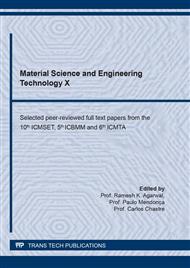p.358
p.367
p.377
p.383
p.389
p.397
p.405
p.410
p.416
Investigation of Thermal and Mechanical Properties of Refractory Materials Produced from Metallurgical Waste
Abstract:
The aim of the research was to investigate the performance of components of metallurgical wastes in the production of high temperature refractories by self-propagating high-temperature synthesis method. The effect of the filter cake waste amounts and their chemical and physical features on refractories’ mechanical and thermal properties were discussed in this study. A detailed thermochemical assessment of the expected chemical reactions in SHS process based on the waste compositions with binder were carried out. The experiments on the obtaining of carbon containing refractories based on the waste of filter cake were conducted. Thermal conductivity coefficients were determined in the context of the thermal properties of refractory samples via a heat flow meter. In addition, mechanical properties were determined by compression strength.
Info:
Periodical:
Pages:
410-415
Citation:
Online since:
February 2022
Price:
Сopyright:
© 2022 Trans Tech Publications Ltd. All Rights Reserved
Share:
Citation:


